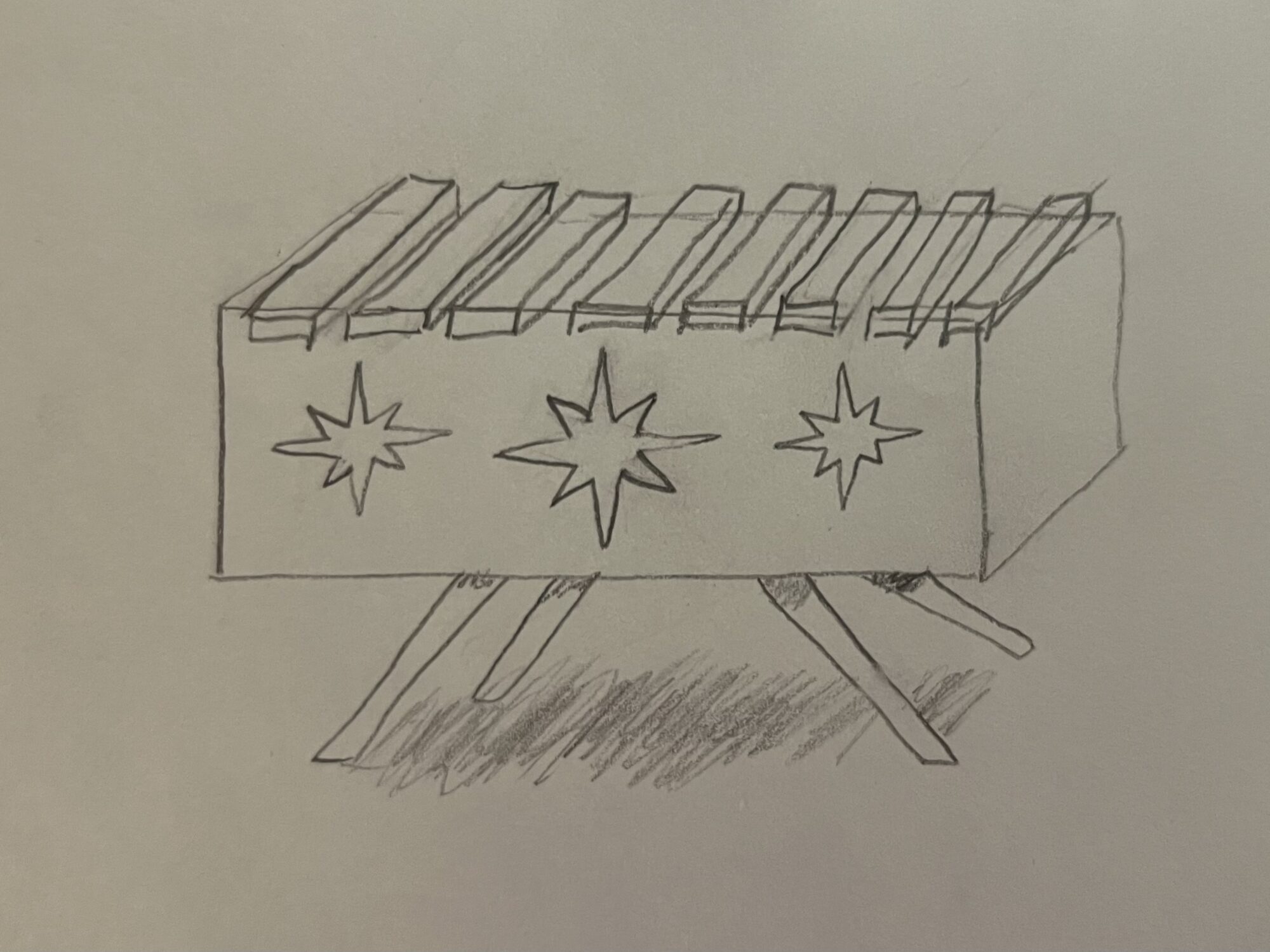My final project is to create a small, box-resonated xylophone in the mid-century modern style. While my main focus on this project is the aesthetic, I would also like this to be a playable instrument. Here are some of my most important specifications and biggest constraints.
Specifications
- Aesthetic
This one is pretty obvious. This project is all about form over function, and I need to do everything I can to make this xylophone look like it’s straight out of the 1956 Woolworth’s Christmas catalog. There are a number of things that I’m going to do to make this aesthetic happen, and they are all necessary parts of the design. The shape is critical, as well as the angled design of the legs, paint color, and classic ’50s star design. I am likely going to choose a dark wood for the keys (like walnut, even though it’s not the best sounding) to work best with the aesthetic. - Size
Xylophones come in all shapes and sizes. Concert xylophones are usually 3 or more octaves, are tall enough to be played while standing, and have resonator tubes under all of the keys to amplify the sound. My xylophone is a much smaller form factor, sort of like what you’d find in an elementary school music class. It doesn’t have any “black keys” (sharps and flats) which will limit the amount of music that can be played on it. However, limiting the size by having just one rank of keys makes the overall design look more appealing (in my opinion). - Functionality
Like I’ve already said, form is the key here. Be that as it may, I really want a playable xylophone. So, I am going to incorporate a number of features to make sure the xylophone is actually playable. Beyond tuning, the xylophone bars have to be carefully suspended so that they actually sound a note when they’re hit (instead of a disappointing thunk). Most mallet instruments are “strung” with black paradors running through holes in the keys at the nodes, or places on the bar that resonate the least (so as to avoid muffling the sound). I’ll hold up the paracord with standoffs drilled into the frame of the xylophone box. - Intonation
This is probably the most difficult specification (which I also talk about in my constraints). Tuning the instrument correctly is going to be critical for it to sound good. Have you ever heard an out of tune piano? Not exactly pretty sounding. - The Stars
The star cutouts are critical to the aesthetic of this project, and really make it obvious that I’m trying to make this thing mid-century modern. If they weren’t there, it would just look like a green box with wonky legs.
Constraints
- My woodworking abilities
I don’t claim to be an expert woodworker. I don’t even claim to be a good woodworker. I know how to turn on a table saw, and probably not cut myself. I’m going to need a lot of help from friends and Idea Forge staff to cut the wood for this project. - Cutting out the stars
Like I said earlier, the stars are critical for the aesthetic of this project to come across. In my design preview, I got some advice to laser cut the design into the wood enough times to cut through. I’m probably going to try this approach, which means using thinner plywood on the front face (probably ¼”). - Tuning
Tuning xylophone bars can be a nightmare. Check out my design preview post for more information. It’s going to be lots of painstaking sanding and checking with a tuner. - Cost
Wood is expensive, and exotic hardwoods used to make xylophone keys are even more so. I would hate for cost to be a limiting factor for this project, but if I have to spend $60 on wood just for the keys, I might have to look at cheaper options to keep the project in budget. - Balance
I am making what is basically a table, after all. Making sure all 4 legs are balanced and the xylophone sits level on a table is something I will have to pay attention to. No one wants a wobbly xylophone.


3 Comments. Leave new
top 15 lists of products and services that can help you to save time and money
Welcome to ‘Top 15 Online,’ your premier destination for expertly curated, up-to-the-minute content exploring the latest trends across a diverse range of interests. Our platform is thoughtfully designed to not only keep you well-informed but also captivated and inspired, offering a thoughtfully selected mix of articles, videos, and insightful perspectives. Whether your interests lie in technology, fashion, travel, well-being, or anything in between, we’re here to satisfy your cravings. Our devoted team of specialists diligently scours the digital landscape to bring you the most relevant and engaging content, ensuring you’re always up-to-date on the most exciting and important developments.
READ MORE -https://www.top15online.com/
Hi Josh, this is a pretty sweet concept! I’m curious, what goes into the tuning of the keys? I can imagine that the exact sizing varies on tons of factors which would be difficult to plan for beforehand. Additionally, do you plan to be able to tune them on the fly or would it be a one time tuning aspect?
Josh I really like this concept and the challenges that probably come with making an instrument. I know you highlighted woodworking is one of your constraints, have you considered making the xylophone a laser cut or wood routed assembly to make the wood working easier on yourself? I think this will be a very cool project when you are done with amazing functionality since you’ll be able to play it.